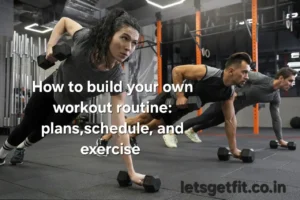
How To Build Your Own Workout Routine: Plans, Schedules, And Exercises

How To Build Your Own Workout Routine: Plans, Schedules, And Exercises
How To Build Your Own Workout Routine: Plans, Schedules, And Exercises: In the Fitness World, workout routines or plans are the essential needs to get success. While the enhancement of the pre-made schedules may seem attractive to you, but the path which is more viable in fitness world in crafting the procedure for your individual needs, goals, choices. Whether you are accomplishing the BodyBuilding, Strength Training, Crossfit, Calisthenics, Weighlifting, doing Cardio, or Weight Loss. This Blog will helps you to Build your Own Workout Routine which includes the Plans, Schedule, Exercises.
OKAY! Are you ready to start building your own routine?
Great! Let’s do this:
- Step 1 – Estimate your Goals and Capabilities
- Step 2 – Select the Equipment’s or Components which helps you in your workout
- Step 3 – Form your schedule
- Step 4 – Prepare the List of Workouts which you will gonna do
- Step 5 – Select the compelling exercises according to your workout plan
- Step 6 – Track your Progress to check whether this routine plan is working properly or not
- Step 7 – Observe the changes on your body
Also Read : WHAT SHOULD I CONSIDER BEFORE SIGNING UP FOR A GYM MEMBERSHIP?
******************************************************************
How To Build Your Own Workout Routine: Plans, Schedules, And Exercises
Step 1 : Estimate your Goals and Capabilities
Before you start any fitness journey, it’s necessary to know where you stand physically now and where you want to be in terms of fitness.SMART— an acronym for Specific, Measurable, Achievable, Relevant, and Time-bound— is a good template for setting your goals.These are the goals that will guide you and help you measure your success in the future.Think about what you want to achieve weight loss, muscle gain, improved endurance or overall health.Your goals should be realistic; they should match with what you can do based on your own abilities and limitations.If you’re unsure about what goals to pursue or how best to reach them safely, consider seeking advice from a fitness professional or medical expert.And remember progress takes time.It’s not an overnight thing but rather a continuous process so be patient with yourself and take time to appreciate every small milestone achieved along the way.
Step 2 : Select the Equipment’s or Components which helps you in your workout
Designing a fitness regimen that balances all aspects necessitates incorporating various components aimed at different fitness domains. This usually includes cardio workouts, building muscle strength, stretching exercises, and relaxation methods. Determining the right proportion of these components involves considering your individual needs and desires. For instance, concentrate on heavy strength workouts for your main goal of muscle gain. Conversely, if your aim is to enhance your heart health, activities such as cycling, swimming, or jogging should be part of your routine. Remember, embracing variety is crucial to prevent monotony and achieve the best outcomes, so feel free to experiment with different exercises until you discover the most effective combination for you.
Step 3 : Form your Schedule
To keep up the pace and advance towards your fitness objectives, it’s essential to establish a consistent workout routine. Consider your interests, everyday schedule, work responsibilities, and the needs of your family when planning your workouts. Schedule them when you’re most likely to stick to them, like early morning, mid-afternoon, or late at night. Allow your body the necessary recovery time by balancing your exercise with rest days. Be aware of your real energy levels and time limitations, and be prepared to adjust your plan due to unexpected events or changes in your priorities. Keep in mind that regular exercise is key, rather than sporadic intense workouts.
Step 4 : Prepare the List of Workouts
Having set a schedule, the next step is to outline the details for each session. This includes choosing appropriate exercises, deciding on sets and repetitions, and organizing your workout in such a way that it leads you to your desired goals. Consider mixing compound and isolation exercises for different muscle groups and strength training: focusing on squats, deadlifts, bench presses, rows, overhead presses. For progressive overload use different strategies such as modifying intensity or volume during warm-up or cool-down activities; be prepared to adjust your plan depending on feedback from your body.
Step 5 : Select the compelling exercises according to your workout plan
Choose exercises that are safe, effective, and aligned with your goals and abilities. Focus on compound movements that engage multiple muscle groups simultaneously, such as squats, deadlifts, lunges, push-ups, and rows. These exercises not only maximize muscle activation but also promote functional strength and movement patterns. Supplement these compound movements with isolation exercises to target specific muscles or address imbalances. Pay close attention to proper form and technique to minimize the risk of injury and optimize results. Consider seeking guidance from a qualified fitness professional or trainer if you’re unsure about how to perform certain exercises correctly. How To Build Your Own Workout Routine: Plans, Schedules, And Exercises
Step 6 : Track your Progress to check whether this routine plan is working properly or not
In order to assess the impact of your training program and make rational modifications when necessary, track your workouts — keep an eye on progress and performance metrics. Write a workout journal or use fitness apps to store details: what exercises you do, how many sets and reps, weight loads, time between sets. Check the progress towards your original goals periodically as it allows you to see how successful you are and identify weak points that should be improved. Encourage yourself on small achievements throughout the process— it helps keep motivation high. And think about introducing regular assessments or fitness tests: strength changes, muscle endurance, body flexibility; also changes in body composition indicators — they will show if what you do brings us closer to our ultimate goal. How To Build Your Own Workout Routine: Plans, Schedules, And Exercises.
Also Read : HOW TO STAY CONSISTENT WITH WORKING OUT
Step 7 : Observe the changes on your body
During your workouts, keep an eye on what your body is telling you and make modifications to your routine if it seems like you are overdoing it or are likely to get injured. Make sure that the fatigue signs, discomfort, pain or any other discomforting sign are carefully taken care of; these include lowering your intensity and volume level or choosing alternative exercises. Always remember that training programs need a good dose of rest and recovery in them, so pay attention to sleep quality and quantity as well as hydration, nutrition, and stress management. Use activities like stretching, foam rolling — low-intensity cardio with yoga as well — in order to promote circulation and reduce muscle soreness; they will help you feel better overall. Listen to your intuition when unsure whether you should take action or not: prioritize your own health above everything else— always be safe!
Conclusion :
Creating your workout plan places you in charge of navigating the seas of your physical fitness adventure and enables you to mold your exertions so they fit like a glove over your individual needs and wants. This can be accomplished by: first appraising your objectives, then developing a well-rounded timetable, choosing potent exercises, and tracking how far along you have come with the program that— apart from being effective in its outcomes— should foster not only fitness but also general health and well-being in the long run. Always keep in mind this well-known saying: ‘Fitness is not about being better than someone else… It’s about being better than you used to be.’ Embrace this sentiment as you move forward on your fitness journey, using it to help guide decisions and frame experiences as you work towards your personal best each day— finding success both large (or small) at every step along the way toward achieving physical mastery over all aspects related directly or indirectly toward attaining optimal wellness throughout life more broadly conceived because remember: fitness really is just part (although important) component included within total picture typically referred simply by “wellness.”How To Build Your Own Workout Routine: Plans, Schedules, And Exercises

